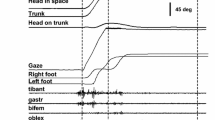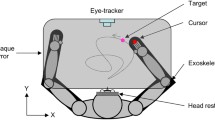Abstract
Gaze pursuit is the coordinated movement of the eyes and head that allows humans and other foveate animals to track moving objects. The control of smooth pursuit eye movements when the head is restrained is relatively well understood, but how the eyes coordinate with concurrent head movements when the head is free remains unresolved. In this study, we describe behavioral tasks that dissociate head and gaze velocity during head-free pursuit in monkeys. Existing models of gaze pursuit propose that both eye and head movements are driven only by the perceived velocity of the visual target and are therefore unable to account for these data. We show that in addition to target velocity, the positions of the eyes in the orbits and the retinal position of the target are important factors for predicting head movement during pursuit. When the eyes are already near their limits, further pursuit in that direction will be accompanied by more head movement than when the eyes are centered in the orbits, even when target velocity is the same. The step-ramp paradigm, often used in pursuit tasks, produces larger or smaller head movements, depending on the direction of the position step, while gaze pursuit velocity is insensitive to this manipulation. Using these tasks, we can reliably evoke head movements with peak velocities much faster than the target’s velocity. Under these circumstances, the compensatory eye movements, which are often called counterproductive since they rotate the eyes in the opposite direction, are essential to maintaining accurate gaze velocity.












Similar content being viewed by others
References
Ackerley R, Barnes GR (2011) The interaction of visual, vestibular and extra-retinal mechanisms in the control of head and gaze during head-free pursuit J Physiol. doi:10.1113/jphysiol.2010.199471
Barnes GR (1993) Visual-vestibular interaction in the control of head and eye movement: the role of visual feedback and predictive mechanisms. Prog Neurobiol 41:435–472
Barnes GR, Collins CJ (2008) Evidence for a link between the extra-retinal component of random-onset pursuit and the anticipatory pursuit of predictable object motion. J Neurophysiol 100:1135–1146. doi:10.1152/jn.00060.2008
Belton T, McCrea RA (2000) Role of the cerebellar flocculus region in the coordination of eye and head movements during gaze pursuit. J Neurophysiol 84:1614–1626
Cullen KE (2012) The vestibular system: multimodal integration and encoding of self-motion for motor control. Trends Neurosci 35:185–196. doi:10.1016/j.tins.2011.12.001
Dubrovsky AS, Cullen KE (2002) Gaze-, eye-, and head-movement dynamics during closed- and open-loop gaze pursuit. J Neurophysiol 87:859–875
Freedman EG (2001) Interactions between eye and head control signals can account for movement kinematics. Biol Cybern 84:453–462
Freedman EG (2008) Coordination of the eyes and head during visual orienting. Exp Brain Res 190:369–387. doi:10.1007/s00221-008-1504-8
Freedman EG, Sparks DL (1997) Eye-head coordination during head-unrestrained gaze shifts in rhesus monkeys. J Neurophysiol 77:2328–2348
Freedman EG, Sparks DL (2000) Coordination of the eyes and head: movement kinematics. Exp Brain Res 131:22–32
Huebner WP, Leigh RJ, Seidman SH, Thomas CW, Billian C, DiScenna AO, Dell’Osso LF (1992) Experimental tests of a superposition hypothesis to explain the relationship between the vestibuloocular reflex and smooth pursuit during horizontal combined eye-head tracking in humans. J Neurophysiol 68:1775–1792
Judge SJ, Richmond BJ, Chu FC (1980) Implantation of magnetic search coils for measurement of eye position: an improved method. Vision Res 20:535–538
Lanman J, Bizzi E, Allum J (1978) The coordination of eye and head movement during smooth pursuit. Brain Res 153:39–53
Leigh RJ, Zee DS (2006) The neurology of eye movements. Oxford University Press. Table of contents only http://www.loc.gov/catdir/toc/ecip0517/2005022301.html Publisher description http://www.loc.gov/catdir/enhancements/fy0637/2005022301-d.html
Rashbass C (1961) The relationship between saccadic and smooth tracking eye movements. J Physiol 159:326–338
Roy JE, Cullen KE (1998) A neural correlate for vestibulo-ocular reflex suppression during voluntary eye-head gaze shifts. Nat Neurosci 1:404–410. doi:10.1038/1619
Roy JE, Cullen KE (2002) Vestibuloocular reflex signal modulation during voluntary and passive head movements. J Neurophysiol 87:2337–2357
Suzuki DA, Betelak KF, Yee RD (2009) Gaze pursuit responses in nucleus reticularis tegmenti pontis of head-unrestrained macaques. J Neurophysiol 101:460–473. doi:10.1152/jn.00615.2007
Wellenius GA, Cullen KE (2000) A comparison of head-unrestrained and head-restrained pursuit: influence of eye position and target velocity on latency. Exp Brain Res 133:139–155
Wickham J (2009) ggplot2: elegant graphics for data analysis. Springer, New York
Author information
Authors and Affiliations
Corresponding author
Rights and permissions
About this article
Cite this article
C. Pallus, A., G. Freedman, E. Target position relative to the head is essential for predicting head movement during head-free gaze pursuit. Exp Brain Res 234, 2107–2121 (2016). https://doi.org/10.1007/s00221-016-4612-x
Received:
Accepted:
Published:
Issue Date:
DOI: https://doi.org/10.1007/s00221-016-4612-x




